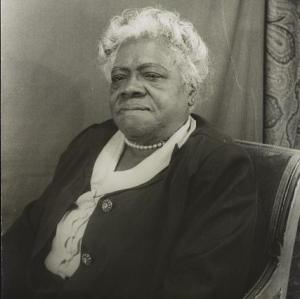Investigating Dr. Mary McLeod Bethune: Uncovering Her Legacy Through Inquisitive Inquiry

In this inquiry-based lesson, students will evaluate how Dr. Mary McLeod Bethune supported civil rights for women and African Americans, engaged in social activism, and how her legacy still impacts the United States today. Students will accomplish this using the Question Formulation Technique (QFT) to brainstorm and generate questions on the life of Dr. Mary McLeod Bethune, and a jigsaw activity to analyze a primary source set. Students will engage in historical discourse to determine Dr. Bethune’s historical contributions while analyzing evidence and making connections.
Guiding Questions
What were Dr. Bethune’s values and how did they shape her actions?
How did Dr. Bethune’s values and actions impact society and contribute to her legacy today?
45-60 minutes recommended
Students will engage in question formation to understand the contributions, significance, and legacy of civil rights trailblazer, Dr. Mary McLeod Bethune. The guiding questions for the lesson include the following: What were Dr. Bethune’s values and how did they shape her actions? How did Dr. Bethune’s values and actions impact society and contribute to her legacy today?
After completing this lesson, students will gain an understanding of the historical significance of Dr. Mary McLeod Bethune through the evaluation of multiple primary sources. Students will develop their historical thinking skills by generating questions, engaging in historical investigation, and collaborating with peers.
Prior to this lesson, it may be beneficial to introduce the Question Formulation Technique or other inquiry-based activities like See-Think-Wonder that involve generating questions. It is important for students to have a background on race relations during the early and mid-twentieth century in the United States.
Supporting Materials
-
Poster Paper
-
Projector or screen for students to see Warm Up Slides
Reference Sources
-
Primary Source Set
-
Short Biography of Dr. Mary McCleod Bethune from the National Women’s History Museum
-
Mary McLeod Bethune: Fighting for Equality in the Classroom and Beyond (NYHS Video)
Warm Up:
Assign students to a group or “home team” of 3-4 students. Pass out one blank poster paper to each group. Students will determine a scribe that will notate all questions generated on the poster paper. Project the Warm Up Activity slides. Walk through the slides with your students, pausing for at least 3 minutes for Image 1, 3 minutes for Image 2, and 3 minutes for Image 3. Approximately 15 minutes is needed for the Warm Up.
Activity:
- Following the Warm Up activity, display the term “values” on the board. Ask students to think-pair-share the following questions: define the term “values” and provide examples of what values mean to you. Instruct students to independently think for 3 minutes followed by pairing and sharing with their shoulder partner for 2 minutes.
- Next, pass out the Primary Source Set (See Materials) to each “home team” and assign a different primary source to each student in their “home team.”
- Assign 10 minutes of silent reading and note-taking. Students will use the Library of Congress Primary Source Analysis Tool to complete their observations, reflections, and questions for their specific primary source.
- After students complete the Primary Source Analysis Tool on their primary source, ask students to form new groups based on their current number/primary source. For instance, all students with Primary Source 1 will form a new group. Tell students that they are to become an expert on their primary source and will be expected to share their source with their “home team.” Ask students to share their observations, reflections, and questions, and discuss the essential question in their new group. Allow students to debrief for 15 minutes. While students are debriefing, pass out a copy of Dr. McLeod Bethune’s biography from the National Women’s History Museum. Have students read the short biography together and discuss the following questions: Using evidence from the primary source, identify Dr. Bethune’s values. How did her values shape her actions?
- Ask students to return to their “home team.” Each group member shall share their observations, reflections, and questions about the primary source they analyzed. Conclude the lesson by sharing the short video summarizing the life of Dr. Mary McLeod Bethune from the New York Historical Society.
Wrap Up:
Discuss the essential question with the whole group: How did Dr. Bethune’s values and actions impact society and contribute to her legacy today?
As an optional exit ticket, students can revisit the questions generated during the QFT warm-up. Students must select one open-ended question they created to answer in a paragraph using the information they gathered from the primary sources. Or students can create two new open-ended questions based on the new information they learned from the lesson.
-
The lesson can be modified by providing students upfront with content-specific vocabulary. A list of bolded vocabulary words can be found at https://wams.nyhistory.org/confidence-and-crises/great-depression/mary-mcleod-bethune/
-
Extension activities: Have students conduct research in pairs to answer their remaining questions generated during the QFT Warm-Up. Students can use their textbooks and websites from the Library of Congress, the National Women’s History Museum, and the New-York Historical Society. Students will note their answers on sticky notes and post them to the original poster papers with their questions.
-
Additional supporting documents to build student and teacher content knowledge.
D2.His.3.9-12. Use questions generated about individuals and groups to assess how the significance of their actions changes over time and is shaped by the historical context
D2.His.12.9-12. Use questions generated about multiple historical sources to pursue further inquiry and investigate additional sources
